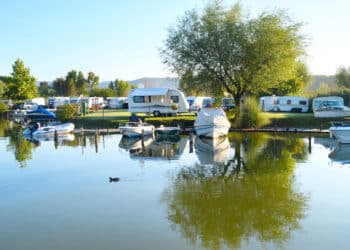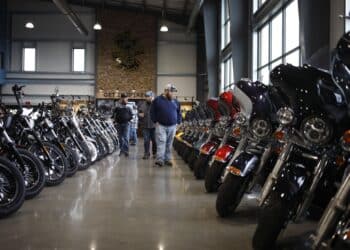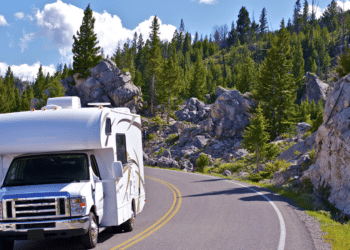NPA’s Woodruff talks goals as freshly minted CEO

After holding positions as the chief technology officer and chief operating officer at National Powersport Auctions, Jim Woodruff was promoted to chief executive, succeeding Cliff Clifford in the role.
A lifelong rider and fan of powersports, Woodruff is the second chief executive in the company’s history and has been with the company for nearly 20 years.
As Woodruff heads into the next stage of his career with NPA, he will guide the company to expand its business to new geographic territories, improve its technology and help the broader powersports industry grow in ridership.
Powersports Finance chatted with Woodruff recently about his goals for the company and about what’s next on the horizon for the auction house. What follows is an edited version of PSF‘s conversation with Woodruff.
Powersports Finance: What are your top priorities for NPA to grow the business?
Jim Woodruff: NPA is already the market leader and best in class at liquidating pre-owned powersports to dealers globally. But the market could be more efficient and there are geographic areas where NPA hasn’t had the reach to make the auction process a feasible option. In the short term, my main priorities to keep NPA on a healthy growth trajectory are facilities, talent, ease of use and efficiency. This means expanding our facility footprint in at least two more geographic locations, hiring and developing top-tier talent as we grow, refining our technology to make it even easier for dealers to do business with us and finding ways for dealers to get inventory faster and more efficiently.
In the long term, NPA’s growth is heavily dependent upon the growth of the powersports market, both new and used. That’s why we are ardent supporters of things like the [Motorcycle Industry Council’s]ridership initiatives, as well as rider training programs, entry-level electric bikes and other efforts to get more people riding more often. We also do everything we can to support finance companies, manufacturers and others who want to enter or expand in the powersports industry. Our mission is not to just grow NPA, but to do our part to help the whole industry grow.
PSF: What lessons do you take from your previous roles as CTO and COO, and how do you plan to apply those lessons to your new role as CEO?
JW: One lesson is how technology has played a huge role in NPA’s success. We build everything ourselves with our own team of software developers, and technology is going to play an even more important role in our industry going forward. Efficiency is another important lesson, not only for NPA but for the whole market. We see many inefficiencies in the powersports market, especially in pre-owned, where our technology, auction marketplace and logistical abilities can make a huge impact. The powersports market is evolving and is not going to look the same in five to 10 years as it does today.
PSF: What are some of the top challenges or issues on your radar? Are there areas where you are allocating more time?
JW: Finding and building out new facilities is a big challenge for us. Between a tight real estate market and stifling regulations in many cities, it takes a lot of work to find, construct and staff a new or expanded facility. We’ve done five in the last two to three years, so we have a good process, but it still has its challenges. Staffing is also a challenge for us as it is for most companies these days. Finding and retaining top talent is a daily quest, and new laws and regulations are making it both more expensive and more difficult to do so. Fortunately, we have amazing people and a one-of-a-kind culture that people want to be part of.
PSF: Are there any new strategies you plan to implement this year?
JW: In addition to new facilities, we want to deploy more mobile technology to make it easier to do business with us. We also want to test other product categories through our auction machine to see if there are other markets where we can add value.
PSF: What do you think is the biggest concern the industry is facing? Sales? Dwindling riders?
JW: I think most people would agree that the biggest industry challenge is ridership. Fortunately, it is not going down, but it is not really growing either. Flat sales and other consequences are the result of stagnant ridership. But I think the challenge is more complex than just enticing new riders, or the myth that millennials don’t ride. For example, we as an industry unintentionally make it really hard to become a new rider. We also make vehicles that are basically the same as they were 20 years ago in an age where consumers expect ease of use, convenience and connectivity in everything they do. And vehicles are more expensive than they used to be; at the same time, consumers have a lot of other discretionary monthly expenses they didn’t have before.
PSF: New sales have been struggling but used sales have been a healthy market. How do you plan to capitalize on that from the auction?
JW: The auction process naturally balances the forces of supply and demand in a market like powersports. The best way for us to capitalize on the healthy used market is to keep being the best at what we do while making it easy for dealers to participate. Sounds easy, but there’s a lot that happens behind the scenes to make it possible.
PSF: What is different about powersports and the auction industry now compared with when you first joined the company? How have you adapted to those changes?
JW: I’ve been working with NPA for almost 20 years, so the changes over that time are too many to list. In many ways it’s the same today as it was back then: a passionate industry driven by enthusiasts that love what they do. But the quality and capability of powersports vehicles, the role of technology, the electrification of vehicles, the professionalization of the dealer network, etc. have all evolved to another level. We still have work to do but, to me, the last 20 years are proof that the next 20 years will be just as exciting.
PSF: If you could take any vehicle in your inventory for a joyride, what would it be?
JW: Tough question! There are so many to choose from. I have owned or ridden some of everything, both street and dirt, so I would probably choose something that I have not tried yet. Something like the Yamaha Nikken, the Harley Livewire, Honda Talon, Indian FTR or an Alta electric MX bike would be on my list of things to try. It would also be fun to try an antique, like a 1916-era board track racer or something crazy like a new, supercharged Kawasaki H2.














